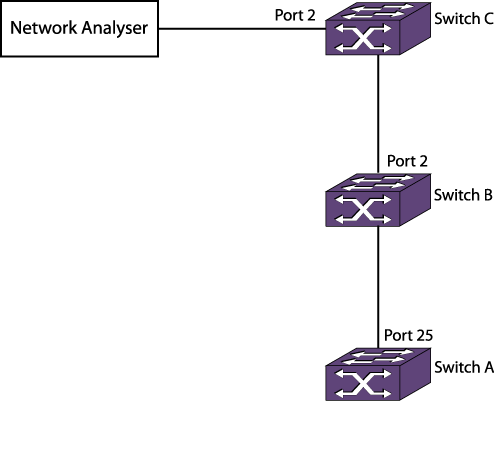Remote mirroring enables the user to mirror traffic to remotely connected switches. Remote mirroring allows a network administrator to mirror traffic from several different remote switches to a port at a centralized location. There are two kinds of remote mirroring: Layer-2 using a remote VLAN tag, and Layer-3 using GRE encapsulation through a routed network to a remote IP address. This section describes remote mirroring using Layer-2. Remote mirroring is accomplished by reserving a dedicated VLAN (Virtual LAN) throughout the network for carrying the mirrored traffic. You can enable remote mirroring on the Summit Family switches.
Remote Mirroring Topology shows a typical remote mirroring topology. Switch A is the source switch that contains ports, VLANs, and/or virtual ports to be remotely mirrored. Port 25 is the local monitor port on Switch A. Switch B is the intermediate switch. Switch C is the destination switch, which is connected to the network analyzer.

All the mirrored packets are tagged with the remote-tag specified by the source switch, whether the packet is already tagged or not. The intermediate switches forward the remote-tagged mirrored packets to the adjacent intermediate/destination switch, as these ports are added as tagged. The port connected to the network analyzer is added as untagged in the destination switch. This causes the destination switch to remove the remote-tag, and the mirrored packet reaches the network analyzer as the source switch sent it.
Unlike basic mirroring, remote mirroring does not remove VLAN membership from the local monitor port(s). This allows remote mirroring to use the existing network topology to transport remote mirrored packets to a destination switch.

 Print
this page
Print
this page Email this topic
Email this topic Feedback
Feedback